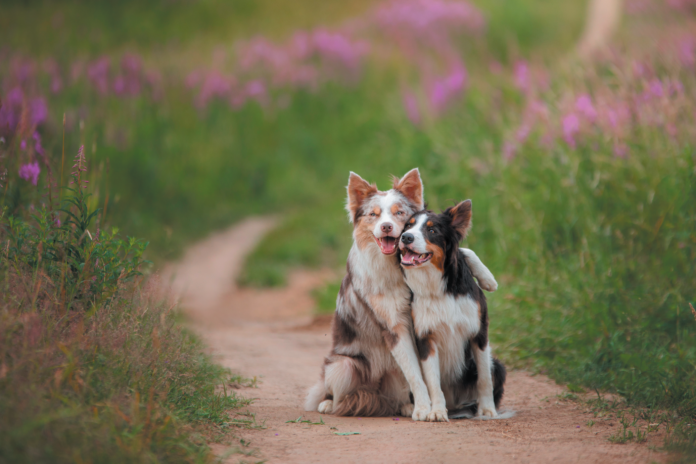You hear it all the time: people say their pet is a “people dog” or a “dog dog,” meaning the dog either likes people or other dogs, but not both.
Of course, in the best of all possible worlds, your dog is not averse to either species. But a dog can get into a frightful scrape with a person or another dog early in life, before she came to live with you, and she then generalizes her fear to all members of that species. She either runs and hides every time she sees a person or another dog, or gets aggressive in order to protect herself.
It’s the aggressive ones you have to worry about in particular, because you don’t want to get into a situation where they can cause harm. And when the phobia is about dogs rather than people, it can be particularly difficult. You can easily ask other people to just keep their distance, but it’s hard to comfortably take a dog outside and go for a walk in peace when every time another dog comes within view, your pet starts acting aggressively to try to scare the other one away.
You can’t cure fear-based aggression toward other dogs. “They may never become the easygoing dogs that you can take to the dog park,” says the head of the Tufts Animal Behavior Clinic, Stephanie Borns-Weil, DVM. Still, she says, while the problem will never go away completely, your dog can still live a satisfying life and go outside without you having to constantly fear altercations. Here are seven empowering steps you can take to help your dog be okay in a world with other people’s dogs.
Always keep in mind that it’s fear, not nastiness. Dogs who act aggressively toward other dogs are not being mean or willful. They’re frightened. When pet owners understand that, “they can have more compassion and treat their dogs more kindly,” Dr. Borns-Weil says. That way, they’re not compounding the dog’s problem of feeling unnerved by yelling at her or angrily yanking her leash.
Don’t try to solve the problem by just throwing your dog in with other dogs. Exposing a scared dog over and over again will not desensitize her, Dr. Borns-Weil says. On the contrary, it will flood her with the very thing she’s afraid of and may sensitize her even more. The thing to do is take your dog to places that are not going to be crowded with other dogs. You especially want to avoid situations where your dog will be on leash but other dogs will be off leash — and in her face.
It doesn’t mean your dog will never be able to be around other dogs. But contact with other dogs has to be achieved gradually, with carefully orchestrated introductions, one dog at a time — and with dogs you know to be gentle and mellow. And you have to reward your pet with treats and warm praise when she doesn’t overreact so she comes to associate being with other dogs as something that brings good results. Your dog will not simply “snap out of it” with lots of random, forced exposure.
Use a head halter or, if your dog is small or brachycephalic, a body harness. Neck collars make for tenuous connections between dogs and their people. Dogs’ necks are not very sensitive to touch. But gentle tugging on a head halter or harness applies pressure where it will count. It’s biologically sensitive, letting your dog know you’re there for her.
True, this removes a dog’s autonomy. “But for a frightened dog it’s like an umbilical cord,” Dr. Borns-Weil says. And it doesn’t choke a pet while it keeps the dog from lunging and snapping.
Use clear, unambiguous communication. Dogs don’t understand, “No, stop it, Toby, I told you not to do that; stop pulling.” To redirect a dog’s attention you have to keep it simple, firmly but without agitation employing the terms you have taught her: “Leave it,” “Stay,” and “Wait.” When she complies, reward her. That way, life remains predictable, which is so much of what a dog needs to keep calm. “Oh, I know those cues! If I do what my owner says, I’ll get a treat and a nice stroke along my muzzle.” That, in turn, will help your pet manage her baseline anxiety.
Allow your dog plenty of exercise. Exercise is critical to decreasing anxiety. Dogs really need to expend energy to feel calm. In fact, if you do everything else and don’t make sure your dog gets enough physical activity (which is more than giving her two walks a day), she will not be able to calm down as much as possible in the presence of other dogs.
You may have to let your dog off leash so she can run around a little. Just put a basket muzzle on her to insure that she doesn’t bite another dog out of fear. The Baskerville Ultra is a good one. It looks like a hockey mask, but your pet can pant in it, drink water while wearing it, and even accept food treats as rewards for good behavior. The muzzle is not a punishment; it’s a way of allowing your dog to have a life.
Think low protein. Protein decreases the amount of a chemical called tryptophan, which is the precursor to serotonin. So the more protein, the less serotonin, which stabilizes mood.
Look for a diet that is 18 to 20 percent protein as dry matter, Dr. Borns-Weil advises. The normal range can go into the 30s, but the lower range is not too low for a dog’s health and may tamp down on her aggressiveness born of fear.
Consider medication, if necessary. If the lifestyle steps recommended here aren’t enough on their own to help keep a dog calm in the presence of other dogs, medication may get her over the hump. Some, like clonidine, last a few hours to help a dog stay calm during her time outside. Others like SSRIs, work 24 hours a day to lower overall background anxiety. Sometimes veterinarians recommend using the two types in combination, Either way, they can often help a dog calm down enough to learn the lessons you’re trying to teach through compassionate leadership. She might not need them forever.






We are experiencing a very strange behavior.
Mostly evening into nighttime, our almost 3 year old (Weimaraner) becomes protective and aggressive, but only to our 16 year old son. Initially we thought it was alpha behavior, then lack of attention (gone for school and work), and now it is just about any time he walks in the room.
After trying to reduce behavior by submission, we choose to ignore the unwanted behaviors and now send he straight to his kennel when he acts out.
Our next step is to make him a neuter appointment. We are at our wits end! The dog was (rescued) for him and he is the primary trainer. We are not inexperienced owners, but this is so frustrating.
Any advice would be appreciated. Thank you.